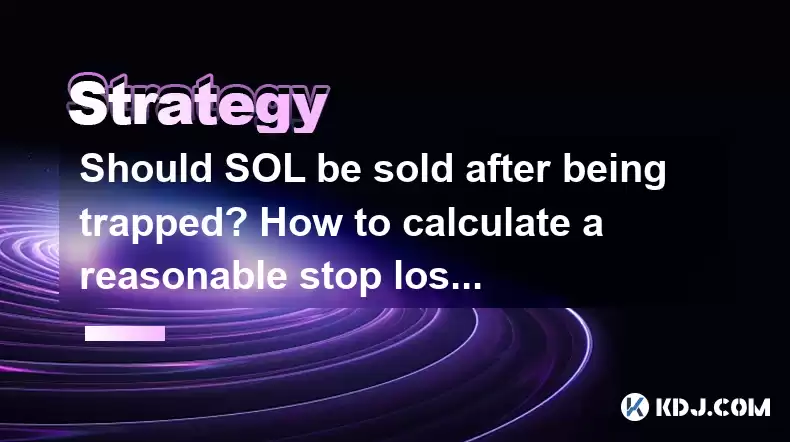-
 bitcoin
bitcoin $112715.707551 USD
-1.71% -
 ethereum
ethereum $4101.475385 USD
-3.01% -
 tether
tether $1.000644 USD
-0.02% -
 bnb
bnb $1207.619465 USD
-6.77% -
 xrp
xrp $2.501451 USD
-3.98% -
 solana
solana $202.947124 USD
-3.32% -
 usd-coin
usd-coin $1.000295 USD
0.04% -
 dogecoin
dogecoin $0.203884 USD
-4.47% -
 tron
tron $0.317154 USD
-1.72% -
 cardano
cardano $0.695009 USD
-4.43% -
 hyperliquid
hyperliquid $38.853961 USD
-8.23% -
 chainlink
chainlink $18.988674 USD
-4.64% -
 ethena-usde
ethena-usde $1.000233 USD
-0.03% -
 stellar
stellar $0.337050 USD
-3.63% -
 bitcoin-cash
bitcoin-cash $536.861728 USD
-1.28%
Should SOL be sold after being trapped? How to calculate a reasonable stop loss position?
If you're trapped with SOL, assess market trends, set a stop loss based on your risk tolerance, and monitor it regularly to manage your investment effectively.
Apr 29, 2025 at 12:22 am

The cryptocurrency market can be both exhilarating and daunting, especially when dealing with assets like Solana (SOL). Many investors find themselves in the uncomfortable position of being 'trapped' with their SOL holdings, wondering whether to sell and how to set a reasonable stop loss position. In this article, we will delve into these crucial questions and provide a detailed guide on navigating these situations.
Understanding Being 'Trapped' with SOL
Being 'trapped' with SOL refers to a situation where an investor holds the cryptocurrency at a price significantly higher than its current market value. This often leads to a dilemma: should you sell at a loss or hold in hopes of a recovery? To make an informed decision, it's essential to assess the reasons behind your investment in SOL and the current market conditions.
If your initial investment in SOL was based on its potential for long-term growth, you might want to consider whether the fundamental reasons for your investment still hold true. Factors such as network upgrades, partnerships, and overall market sentiment towards Solana can influence your decision. On the other hand, if your investment was more speculative, you might need to reassess your risk tolerance and investment strategy.
Factors to Consider Before Selling SOL
Before deciding to sell your SOL, it's crucial to evaluate several key factors:
Market Trends: Analyze the recent price movements of SOL and compare them to the broader cryptocurrency market. Are there any significant trends that suggest a potential recovery or further decline?
Fundamental Analysis: Look into Solana's development progress, upcoming upgrades, and partnerships. Are there any positive developments that could drive the price up in the future?
Technical Analysis: Use technical indicators such as moving averages, RSI, and MACD to gauge the current momentum and potential reversal points for SOL.
Risk Tolerance: Assess your personal risk tolerance and financial situation. Can you afford to hold onto SOL for an extended period, or do you need to liquidate your position to mitigate losses?
Calculating a Reasonable Stop Loss Position
Setting a stop loss is a critical strategy for managing risk in cryptocurrency trading. A stop loss order automatically sells your SOL when it reaches a predetermined price, helping to limit potential losses. To calculate a reasonable stop loss position for SOL, follow these steps:
Determine Your Risk Tolerance: Decide how much of your investment you are willing to risk. A common rule of thumb is to risk no more than 1-2% of your total trading capital on a single trade.
Identify Key Support Levels: Use technical analysis to identify key support levels for SOL. These are price levels where the asset has historically found buying interest and could potentially bounce back.
Calculate the Stop Loss Price: Based on your risk tolerance and identified support levels, calculate the stop loss price. For example, if you bought SOL at $100 and are willing to risk 2% of your investment, your stop loss price would be $98 if the nearest support level is at $98.
Set the Stop Loss Order: Once you have determined the stop loss price, set the order on your trading platform. Ensure that the stop loss is placed at a level that allows for normal market fluctuations but protects you from significant downturns.
Practical Steps to Set a Stop Loss on SOL
Setting a stop loss order for SOL involves specific steps that vary depending on the trading platform you use. Here is a general guide using a popular platform like Binance:
Log into Your Account: Open the Binance website or app and log into your account.
Navigate to the SOL Trading Page: Go to the trading section and select the SOL/USDT or SOL/BTC trading pair, depending on your preference.
Access the Order Form: Click on the 'Order' tab to access the order form.
Select Stop-Limit Order: Choose the 'Stop-Limit' order type from the available options.
Enter the Stop Price: Input the stop price you calculated earlier. This is the price at which the stop loss order will be triggered.
Enter the Limit Price: Set the limit price, which is the price at which the order will be executed once the stop price is reached. The limit price should be slightly lower than the stop price to ensure the order is filled.
Set the Amount: Enter the amount of SOL you want to sell with the stop loss order.
Review and Submit: Double-check all the details, then submit the order.
Monitoring and Adjusting Your Stop Loss
Once your stop loss order is in place, it's important to monitor the market and adjust your stop loss as necessary. Here are some tips for effective monitoring and adjustment:
Regularly Review Market Conditions: Keep an eye on SOL's price movements and overall market trends. Adjust your stop loss if you believe the market conditions have changed significantly.
Use Trailing Stop Loss: Consider using a trailing stop loss, which automatically adjusts the stop price as the market price of SOL moves in your favor. This can help you lock in profits while still protecting against downturns.
Stay Informed: Stay updated with news and developments related to Solana. Positive or negative news can significantly impact the price and may require adjustments to your stop loss strategy.
Emotional Management When Trapped with SOL
Being trapped with SOL can be emotionally challenging. Here are some tips for managing your emotions and making rational decisions:
Avoid Emotional Trading: Do not let fear or greed drive your decisions. Stick to your predetermined strategy and risk management rules.
Take a Break: If you find yourself becoming overly stressed, take a break from monitoring the market. Sometimes, stepping away can help you regain perspective.
Seek Advice: Consider seeking advice from experienced traders or financial advisors. They can provide valuable insights and help you navigate the situation more effectively.
FAQs
Q: How often should I adjust my stop loss for SOL?A: The frequency of adjusting your stop loss depends on market volatility and your trading strategy. In highly volatile markets, you might need to adjust your stop loss more frequently to protect against sudden price drops. However, if you are holding SOL for the long term, you might adjust it less often, perhaps weekly or monthly, based on significant market changes.
Q: Can I use a stop loss strategy for other cryptocurrencies besides SOL?A: Yes, the stop loss strategy is applicable to all cryptocurrencies. The key is to adapt the strategy to the specific volatility and market conditions of each cryptocurrency. For instance, highly volatile assets like Bitcoin or Ethereum may require different stop loss settings compared to less volatile altcoins.
Q: What should I do if my stop loss is triggered and SOL starts to recover?A: If your stop loss is triggered and SOL begins to recover, it's important not to chase the price immediately. Reassess the market conditions and your investment strategy. If you still believe in the long-term potential of SOL, you might consider re-entering the market at a more favorable price. However, always ensure that any new investment aligns with your risk management rules.
Q: Is it better to use a stop loss or a take profit order for SOL?A: Both stop loss and take profit orders are essential tools for managing risk and securing profits. A stop loss helps limit potential losses, while a take profit order locks in gains when the price reaches a certain level. The choice between the two depends on your trading strategy and risk tolerance. Some traders use both simultaneously to create a balanced approach to managing their SOL positions.
Disclaimer:info@kdj.com
The information provided is not trading advice. kdj.com does not assume any responsibility for any investments made based on the information provided in this article. Cryptocurrencies are highly volatile and it is highly recommended that you invest with caution after thorough research!
If you believe that the content used on this website infringes your copyright, please contact us immediately (info@kdj.com) and we will delete it promptly.
- Zero Knowledge Proof, Whitelist, Blockchain 2025: The Dawn of Private, Scalable Infrastructure
- 2025-10-16 01:20:01
- Altcoins, Whales, and Tariff Threats: Navigating the Crypto Seas
- 2025-10-16 01:20:01
- ChatGPT's Crystal Ball: HBAR Price Prediction and the Rise of Snorter in 2025
- 2025-10-16 01:20:01
- ZEROBASE Listing and Airdrop: A New Era for ZK Tech?
- 2025-10-16 00:25:13
- Digital Euro, Gold Standard, and Active Reserves: A New York Minute on the Future of Money
- 2025-10-16 00:25:13
- TCG OTS Pack Spoilers: What's Hot and What's Not?
- 2025-10-16 00:33:47
Related knowledge

Practical parameter settings for a Bitcoin multi-timeframe moving average system
Sep 18,2025 at 10:54pm
Optimizing Timeframe Combinations for Bitcoin Trading1. Selecting appropriate timeframes is crucial when building a multi-timeframe moving average sys...

How can I filter out false breakouts in Dogecoin high-frequency trading?
Sep 22,2025 at 01:00am
Understanding False Breakouts in Dogecoin Trading1. A false breakout occurs when Dogecoin's price appears to move beyond a defined support or resistan...

Techniques for identifying tops and bottoms in the Bitcoin on-chain NVT model
Sep 20,2025 at 07:54pm
Understanding the NVT Model in Bitcoin Analysis1. The Network Value to Transactions (NVT) ratio is often described as the 'P/E ratio' of the cryptocur...

What does the surge in open interest in Bitcoincoin futures mean?
Sep 20,2025 at 11:18pm
Understanding the Surge in Dogecoin Futures Open Interest1. A surge in open interest within Dogecoin futures indicates a growing number of active cont...

How can I use the Ethereum USDT premium to gauge market sentiment?
Sep 18,2025 at 11:55pm
Understanding the Ethereum USDT Premium1. The Ethereum USDT premium refers to the price difference between USDT (Tether) traded on Ethereum-based plat...

What should I do if Ethereum staking yields decline?
Sep 20,2025 at 06:18am
Understanding the Causes Behind Declining Ethereum Staking Yields1. The Ethereum network transitioned to a proof-of-stake consensus mechanism with the...

Practical parameter settings for a Bitcoin multi-timeframe moving average system
Sep 18,2025 at 10:54pm
Optimizing Timeframe Combinations for Bitcoin Trading1. Selecting appropriate timeframes is crucial when building a multi-timeframe moving average sys...

How can I filter out false breakouts in Dogecoin high-frequency trading?
Sep 22,2025 at 01:00am
Understanding False Breakouts in Dogecoin Trading1. A false breakout occurs when Dogecoin's price appears to move beyond a defined support or resistan...

Techniques for identifying tops and bottoms in the Bitcoin on-chain NVT model
Sep 20,2025 at 07:54pm
Understanding the NVT Model in Bitcoin Analysis1. The Network Value to Transactions (NVT) ratio is often described as the 'P/E ratio' of the cryptocur...

What does the surge in open interest in Bitcoincoin futures mean?
Sep 20,2025 at 11:18pm
Understanding the Surge in Dogecoin Futures Open Interest1. A surge in open interest within Dogecoin futures indicates a growing number of active cont...

How can I use the Ethereum USDT premium to gauge market sentiment?
Sep 18,2025 at 11:55pm
Understanding the Ethereum USDT Premium1. The Ethereum USDT premium refers to the price difference between USDT (Tether) traded on Ethereum-based plat...

What should I do if Ethereum staking yields decline?
Sep 20,2025 at 06:18am
Understanding the Causes Behind Declining Ethereum Staking Yields1. The Ethereum network transitioned to a proof-of-stake consensus mechanism with the...
See all articles










































































